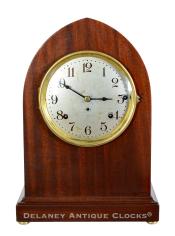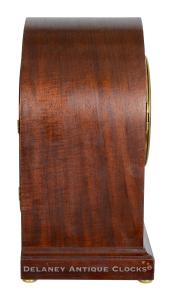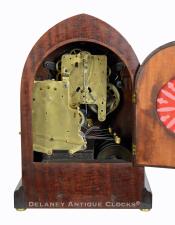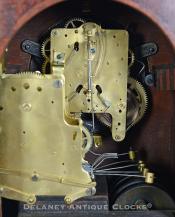Sonora Chime clock, 5-bells, by the Seth Thomas Company. The Chime Clock No. 14. 223214A.
The Seth Thomas Clock Company, a renowned clock manufacturer based in Thomaston, Connecticut, produced this mahogany-cased Doric shelf clock. The company is known for its high-quality craftsmanship and innovative clock designs.
Seth Thomas' Sonora Chime clocks are known for having two separate brass movements. The front movement is Seth Thomas' Number 89, which features a deadbeat time-and-strike/half-hour strike design that strikes a bell on the hour. It is powered by two coiled steel springs and is designed to run for eight days when fully wound. The second set of works is mounted behind the primary movement. This set is powered by a large spring. The quarter chiming mechanism, movement #90B, is known as the Four-bell Sonora chime setup. The main works activate this movement. Once triggered, the second set will begin to strike the Westminster tune, a progressive sequence: four strikes on the first quarter hour, eight on the half-hour, twelve on the three-quarter, and sixteen blows on the hour. The bells produce pure tones and rich melodies, creating an incredible sound that often surprises first-time listeners.
A lever is mounted on the side of the case. One would move this to select the clock striking options. It has two positions, on or off. When set in the off position, a metal bar prevents the clock from striking the quarter hours only.
This simple case form, often called the Doric form by clockmakers for its elegant and understated design, is constructed in oak and veneered in tiger mahogany. The wood has been recently refinished. The mahogany wood presents a rich, warm color enhanced by its high-polished finish. The simple case design does well to hide the complex movement hidden within.
The dial bezel is brass and fitted with a convex piece of glass with a beveled edge. This bezel closes tight via a pressure fit. The silvered dial features painted Arabic numerals and minute dots. "MADE BY SETH THOMAS IN USA" is printed below the time ring. The speed adjustment is located below the center arbor and is adjusted with a key. The hands are spade-shaped and contrast nicely against the silver-washed dial.
The model number 14 sold for $36 in 1911.
The Seth Thomas Clock Company made this clock circa 1911. It measures an impressive 14.5 inches tall.
Please keep in mind that this clock has been professionally serviced and is in excellent working order. The movement has been completely disassembled. The parts have been cleaned with a clock cleaning solution in an ultra-sonic cleaner. The works are then rebuilt, inspecting for wear. All worn holes are rebushed. The pivots are repolished. The works are then lubricated and tested.
Inventory number 223214A.
Seth Thomas was born in Wolcott, Connecticut, in 1785. He was apprenticed as a carpenter and joiner and worked building houses and barns. He started in the clock business in 1807, working for clockmaker Eli Terry. Thomas formed a clock-making partnership in Plymouth, Connecticut, with Eli Terry and Silas Hoadley as Terry, Thomas & Hoadley. In 1810, he bought Terry's clock business, making tall clocks with wooden movements. Seth chose to sell his shares in the partnership in 1812, moving in 1813 to Plymouth Hollow, Connecticut, where he set up a factory to make metal-movement clocks. In 1817, he added shelf and mantel clocks. By the mid-1840s, He successfully transitioned to brass movements and expanded his operations by building a brass rolling mill and a cotton factory. In 1853, He incorporated the business but continued to be the majority shareholder. This clock business expanded until it became one of the "BIG Seven" in Connecticut. Their product line had offerings that competed at every price point, from kitchen clocks to precision regulators. Seth Thomas died in 1859. The community of Plymouth Hollow so revered him that they changed the name on July 6, 1875, to Thomaston in his honor. After his death, his son, Aaron, took over the company's leadership. Aaron is credited with increasing the business by adding a number of new case styles and improving production methods. The company went out of business in the 1980s.














